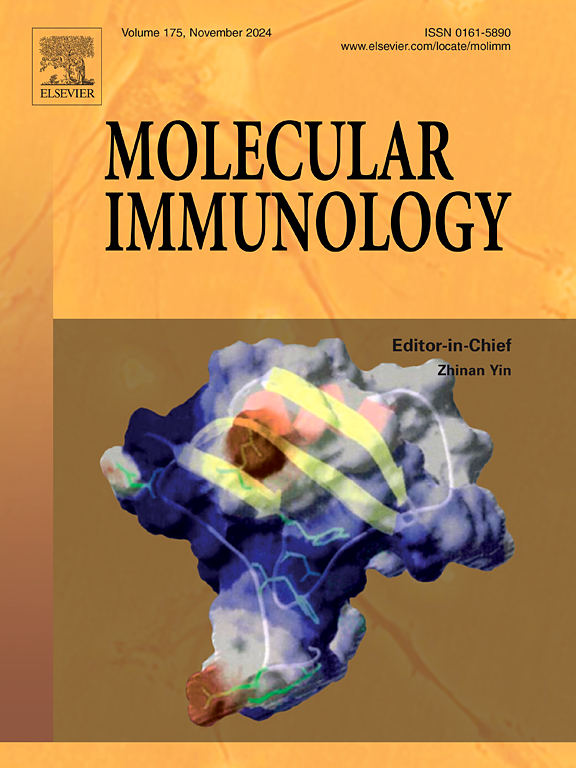紫苏细胞外囊泡的抗炎和抗氧化作用:来自斑马鱼模型的见解
IF 3
3区 医学
Q2 BIOCHEMISTRY & MOLECULAR BIOLOGY
引用次数: 0
摘要
植物源性细胞外囊泡因其独特的生物特性和固有的治疗活性,最近已被提取出来,并被认为是有前景的生物活性分子。在这项研究中,我们研究了紫苏源性类外泌体纳米颗粒(PELNs)的理化特征、生物活性特性和治疗潜力。透射电子显微镜(TEM)显示,PELNs呈杯状形态,具有脂质双分子层,大小分布在40至200纳米之间(平均:68.4 ± 13.0纳米)。通过多组学和小 RNA 测序分析了 PELNs 中的货物。对斑马鱼的体内研究表明,PELNs 在实验浓度下是无毒的。中性粒细胞向受伤鱼鳍迁移的减少证明了 PELNs 的抗炎特性。此外,通过对转录组数据进行荟萃分析,在三个实验组的 12 个样本中发现了数百个差异表达基因(DEGs)。根据基因本体论(GO)富集分析,这些 DEGs 被注释为三个类别。此外,京都基因和基因组百科全书(KEGG)通路分析表明,这些 DEGs 参与了免疫相关通路,包括补体和凝血级联、系统性红斑狼疮、PPAR 信号通路以及抗原处理和呈递。通过定量实时聚合酶链反应(qRT-PCR)对所选的12个DEGs进行了验证,尤其是通过原位杂交确认了mpx和lcp1基因。此外,PELNs 还通过降低活性氧(ROS)水平而显示出抗氧化作用,这一点可以通过测量 H2O2 诱导的氧化应激(OS)斑马鱼幼体中的四种氧化应激(OS)指标(即 SOD、CAT、GSH 和 MDA)得到证明。总之,PELNs 具有显著的抗炎和抗氧化特性,突出了其作为治疗各种炎症性疾病的药物的潜力。本文章由计算机程序翻译,如有差异,请以英文原文为准。
Anti-inflammatory and antioxidative effects of Perilla frutescens-derived extracellular vesicles: Insights from Zebrafish models
Plant-derived extracellular vesicles have recently been extracted and recognized as promising bioactive molecules, owing to their distinctive biological properties and inherent therapeutic activities. In this study, we investigated the physicochemical characteristics, bioactive properties, and therapeutic potential of Perilla frutescens-derived exosome-like nanoparticles (PELNs). Transmission electron microscopy (TEM) revealed that PELNs exhibited a cup-shaped morphology, with a lipid bilayer and a size distribution ranging from 40 to 200 nm (mean: 68.4 ± 13.0 nm). The cargoes in PELNs were analyzed through multi-omics and small RNA sequencing. In vivo studies on zebrafish demonstrated that PELNs are non-toxic at experimental concentrations. A reduction in neutrophil migration to injured fins evidenced the anti-inflammatory properties of PELNs. Furthermore, a meta-analysis of transcriptomic data identified hundreds of differentially expressed genes (DEGs) across 12 samples of three experimental groups. These DEGs were annotated into three categories following gene ontology (GO) enrichment analysis. Additionally, Kyoto Encyclopedia of Genes and Genomes (KEGG) pathway analysis revealed that these DEGs were involved in immune-related pathways, including complement and coagulation cascades, systemic lupus erythematosus, PPAR signaling pathways, and antigen processing and presentation. Twelve selected DEGs were validated by quantitative real-time PCR (qRT-PCR), with particular confirmation of the mpx and lcp1 genes via in situ hybridization. Furthermore, PELNs demonstrated antioxidative effects by mitigating reactive oxygen species (ROS) levels, as evidenced by measurements of four oxidative stress (OS) indicators (i.e., SOD, CAT, GSH, and MDA) in zebrafish larvae subjected to H2O2-induced OS. In summary, PELNs exhibit substantial anti-inflammatory and antioxidant properties, underscoring their potential as therapeutic agents for treating various inflammatory diseases.
求助全文
通过发布文献求助,成功后即可免费获取论文全文。
去求助
来源期刊

Molecular immunology
医学-免疫学
CiteScore
6.90
自引率
2.80%
发文量
324
审稿时长
50 days
期刊介绍:
Molecular Immunology publishes original articles, reviews and commentaries on all areas of immunology, with a particular focus on description of cellular, biochemical or genetic mechanisms underlying immunological phenomena. Studies on all model organisms, from invertebrates to humans, are suitable. Examples include, but are not restricted to:
Infection, autoimmunity, transplantation, immunodeficiencies, inflammation and tumor immunology
Mechanisms of induction, regulation and termination of innate and adaptive immunity
Intercellular communication, cooperation and regulation
Intracellular mechanisms of immunity (endocytosis, protein trafficking, pathogen recognition, antigen presentation, etc)
Mechanisms of action of the cells and molecules of the immune system
Structural analysis
Development of the immune system
Comparative immunology and evolution of the immune system
"Omics" studies and bioinformatics
Vaccines, biotechnology and therapeutic manipulation of the immune system (therapeutic antibodies, cytokines, cellular therapies, etc)
Technical developments.
 求助内容:
求助内容: 应助结果提醒方式:
应助结果提醒方式:


